With the rise of food delivery apps, the food delivery business is at the cutting edge of new ideas at a time when digital solutions and ease of use are the norm. This detailed guide looks at how food service apps have changed over time and what they mean in today’s world.
Did you know the global online food delivery market was worth USD 254.52 billion in 2023 and is expected to grow (USD 505.50 billion) at 10.3% CAGR from 2023 to 2030?
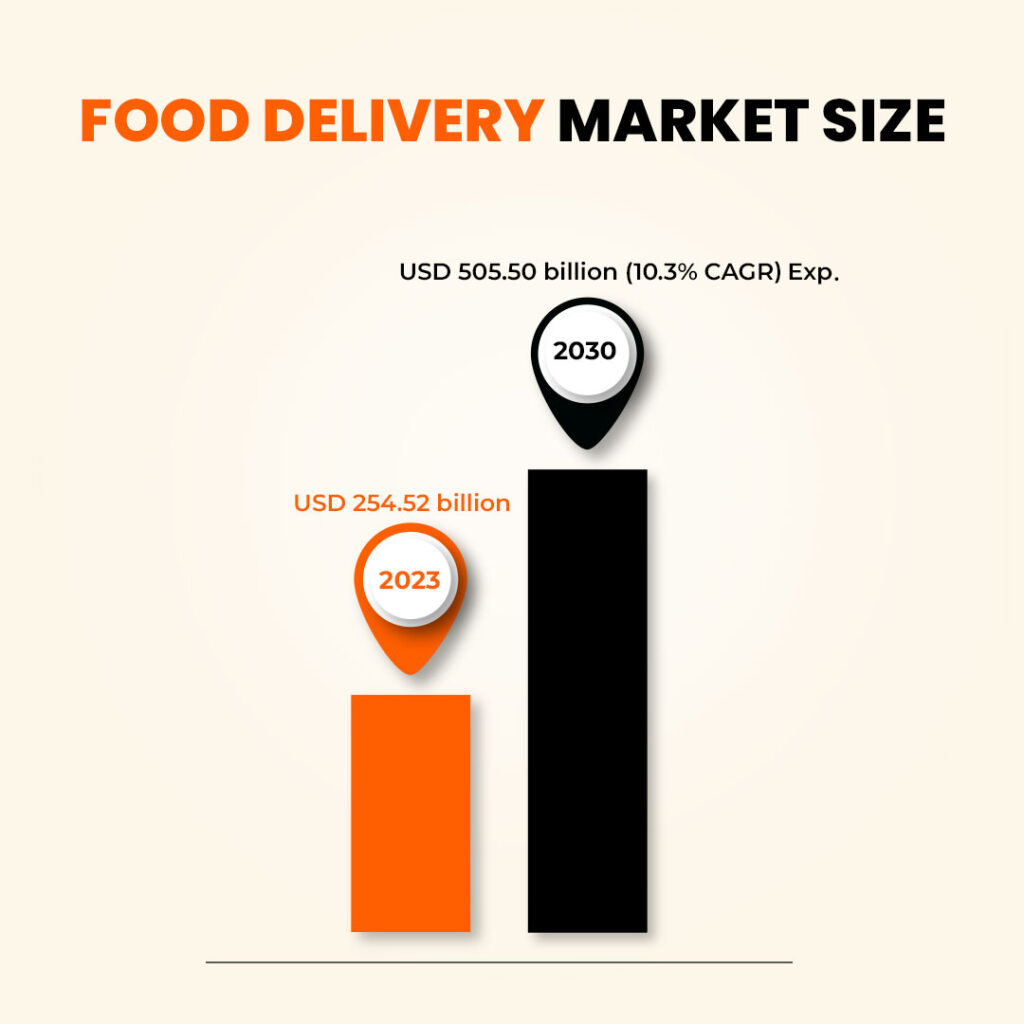
The market for online meal delivery was worth USD 24.96 billion in 2023, and it is expected to grow at a rate of 10.5% per year from 2024 to 2032.
Every part is looked at in detail, from the rise in demand in the food business to market trends, financial opportunities, and important features. We also talk about the complicated parts of food delivery app development, such as prices, ways to make money, technology needs, testing, rollout, and plans for a smooth launch into the market. Come along with us as we explore the world of food service apps.
What is a Food Delivery App Development?
Food delivery apps are online tools that put customers in touch with food sellers or restaurants to look at menus, place orders, and bring food to their door. These apps have changed how people eat by making it easier and giving people more options when choosing meals from various restaurants and types of food.
After downloading the app to their phones and making an account, users can look for nearby places or specific meals they like. With real-time tracking, safe payment options, and personalized suggestions, food delivery apps make buying easier, so you don’t have to use the phone or paper choices. They also often give extras like discounts, reward programs, and special deals, which make users more interested and satisfied.
These apps are a great way for food sellers and businesses to get more customers and make more money without spending on extra equipment or marketing. Businesses with food delivery sites can reach more people and take advantage of the growing demand for services that let people buy and get delivered food online. Food delivery apps have become an important part of modern eating culture. They offer users unbeatable ease, choice, and accessibility while giving food businesses rich chances.
Why is the Food Industry Booming?
There has never been a boom like this in the food business. It’s due to a mix of new technologies and changed customer habits. Food delivery services have become very popular because more people want things to be easy, and faster-paced lives are becoming more common.
The food service business has grown to meet the needs of people who want quick, easy, and varied meal choices. The digital revolution has also helped this change because it has made it easier for customers to find different food options with just a few clicks on their phones.
In addition, the pandemic has sped up this trend, as lockdowns and other steps to keep people from getting too close have made online food delivery a must for many. People became used to using food delivery apps during the pandemic and are now used to their ease of use and variety.
This has led to steady growth even as the world returns to normality. Also, the arrival of many new players into the market has made it more competitive, which has led to new ideas, better service, and more food choices for customers. This healthy environment benefits customers and gives entrepreneurs and companies new ways to spend and do well in the growing food industry.
Market Overview
The fast spread of online platforms is fueling strong growth in the global foodservice market. Zomato, Swiggy, DoorDash, and Uber Eats, all constantly coming up with new strategies to gain a larger market share, are the market leaders as per the recent update.
The industry is growing even faster thanks to technological improvements, more people having smartphones, and changing customer tastes that favor ease and variety. The gig economy and more city people also greatly impact the market. People are spending a lot more on food delivery services, so the market is set to keep growing. This means both new and current companies can find plenty of chances.
Reasons To Invest in Food Delivery Apps
Here are some reasons you should invest in a food app –
Increasing Need for Speed
These days, people value speed more than anything else, which has led to a rise in the need for food delivery services that make it easy to get a range of foods.
Growing Customer Base
The number of people using food delivery services is growing. This includes families, busy workers, and youth who would rather order food online than go to a restaurant.
Technological Progress
Adding new technologies like AI, ML, and data analytics to food apps makes them better for users and more efficient, which makes the investment more profitable.
Diverse Sources of Income
Food apps make money in various ways, such as through delivery fees, restaurant commissions, ads, and special subscription models. This gives them a fair and varied income.
Potential for Market Growth
The food delivery market is predicted to keep growing, so buying early can pay off big as the field grows.
Brand Awareness and Growth
A food app can help restaurants and other food service businesses raise brand awareness, reach more people, and explore new markets without opening more stores.
Customers
Food apps give businesses useful information about what customers like and how they buy things. This information can be used for focused marketing and personalized services that make customers happier and more likely to stick with a business.
Features of Food Delivery App Development
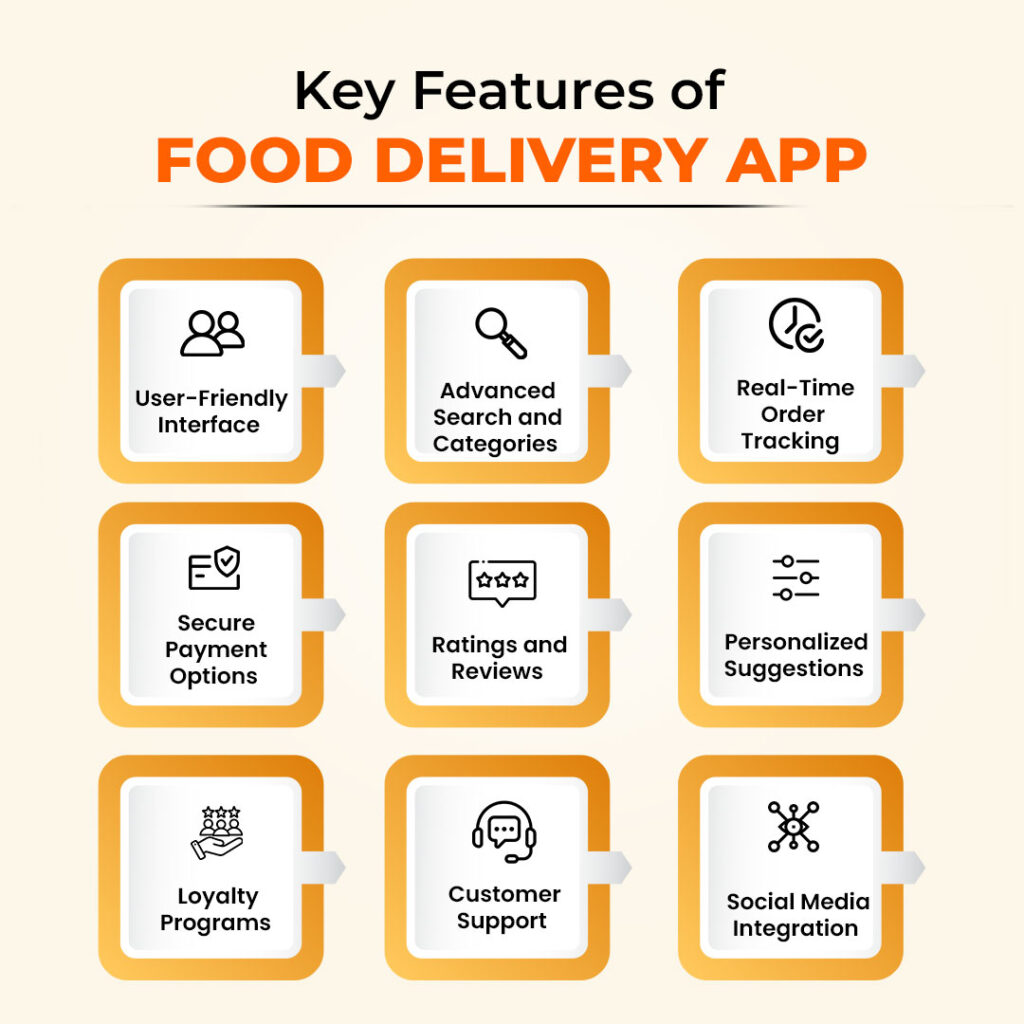
A good food delivery app has many parts that work together to make it easier for people to use, make things run more smoothly, and ensure that clients and businesses are happy and satisfied. These are some important things:
- User-Friendly Interface: An interface that is simple, easy to understand, and quick to use so that people can quickly look at options, place orders, and pay.
- Advanced Search and Categories: This feature lets users look for places, types of food, or specific meals. They can also use categories to narrow their search based on price, reviews, delivery time, and other factors.
- Real-Time Order Tracking: This feature lets customers keep an eye on their order, from when it’s being prepared to when it’s delivered.
- Secure Payment Options: Accepts many payment methods, such as credit and debit cards, mobile wallets, and Internet banking, ensuring that transfers are safe and easy.
- Ratings and Reviews: This feature lets customers rate their experience and leave reviews for restaurants and service staff, which builds trust and openness.
- Personalized Suggestions: AI and machine learning are used to make personalized suggestions for meals and places based on what the user has previously ordered and liked.
- Loyalty Programs: These rewards and loyalty programs encourage customers to buy from you again, which helps you keep customers.
- Customer Support: Treats questions, issues, and reviews with quick and helpful customer service.
- Integration with Social Media: This feature lets users share their eating experiences or favorite foods on social media sites from the app.
Food Delivery App Development Cost
Food delivery app development costs a lot of different things, such as how complicated it is, what features it has, whether it is for iOS, Android, or both, and where the coders are located. One platform for a simple food delivery app with the most important features, like looking at menus, placing orders, and processing payments, could cost between 50 and 100 dollars.
For a more advanced app with features like real-time tracking, AI-based suggestions, reward programs, and support for more than one language, the price can go up to $20,000 or more. This is very important if the app is made in a high-wage market.
It may also cost more if you need custom designs, user interfaces that are hard to understand, or server systems that can handle a lot of data and deals. Also, consider how much it will cost to keep the app updated, sell it, and maintain it after it is out there. In a crowded market, this will help it stay successful and important.
Business’s Revenue Model
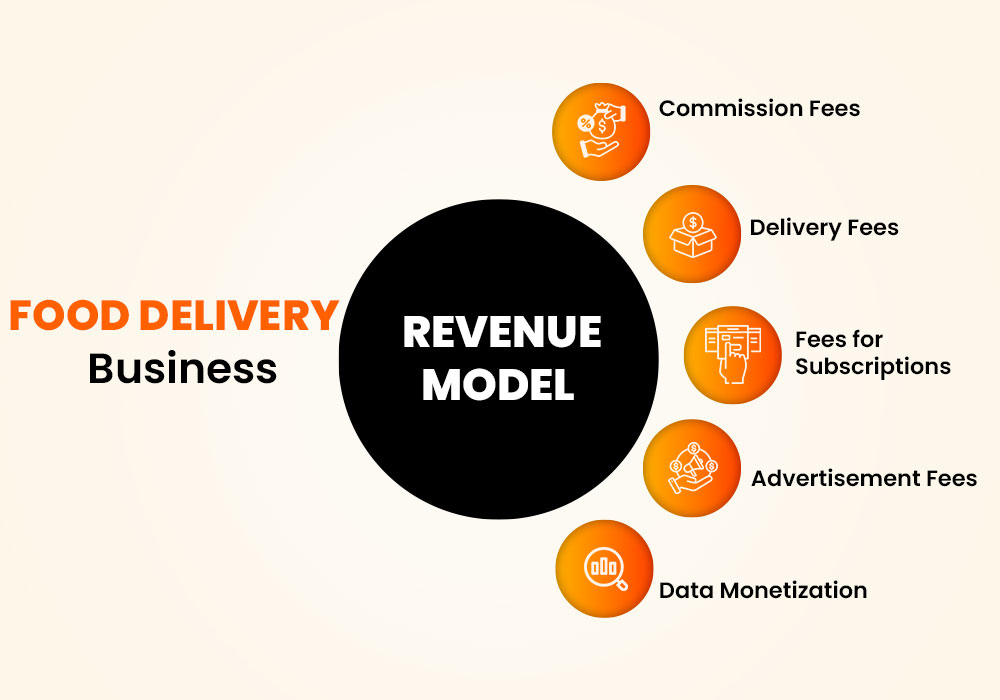
A food delivery app’s income plan is one of the most important factors determining its long-term success and ability to make money. Most of the time, these apps use a mix of different ways to make money to make the most money while still giving users and businesses value. For a food service business, the following are important parts of its income model:
Commission Fees
One of the main ways apps make money is by giving restaurants a cut of every order that comes through their site. This fee can be anywhere from 15% to 30%, based on the terms of the deal and the services given.
Delivery Fees
Customers may be charged a delivery fee depending on how far away they live or how much they order. This fee can be a straight source of income or used to cover the costs of running a delivery service.
Fees for Subscriptions
Many food delivery apps have programs where you can sign up and get perks like free service, savings, or special deals. Subscriptions are a reliable way to make money and keep customers coming back.
Advertisement Fees
Apps can make money by renting out ad space to restaurants or other companies related to the app and wanting more exposure on the platform. Featured entries, spot ads, and marketing efforts are examples.
Data Monetization
Apps can learn about how people use their services and what they like by looking at the data they collect about them. This information can be used for focused marketing or sold to people interested in food market trends.
Essential Steps To Build a Food Delivery App like Zomato/Swiggy
Creating a food delivery app includes several important steps, each affecting how well the app works, how users feel about it, and how well it does in the market. Here is a list of the most important steps in the creation process:
- Market research and analysis include learning about the target audience, rivals, and market trends to develop unique selling points and feature needs.
- Setting up the business model means making a detailed breakdown of how to make money, run the company, and identify the main players, such as customers, restaurants, and service staff.
- Choose the features that are most essential for the MVP (Minimum Viable Product) and plan to add more in later releases.
- UI/UX design creates user interfaces and experiences that are natural, interesting, and simple for everyone to use.
- Picking the right tools for developing the front and back ends, managing databases, and running servers.
- Writing code for the app, including building the back end and making the front end work on iOS, Android, and the web, as well as adding third-party services like payments, maps, and SMS.
- Tests for usability and quality assurance include functional, usage, speed, and security assessments to ensure the application is free of bugs and intuitive.
- The process of deploying an app involves placing it on the Google Play Store and the Apple App Store and making sure the server infrastructure is scalable and reliable.
- Planning and executing marketing campaigns to encourage users to download and launch the app is the marketing and launch strategy.
- After the app is released, gather user feedback and iterate by adding features or making any necessary changes to improve the app.
Required Tech Stack for Food Delivery App Development
To make a reliable and expandable food delivery app, you need a full tech stack that includes different technologies for client-side and server-side development and other important features. The tech stack that a food service app needs is broken down below:
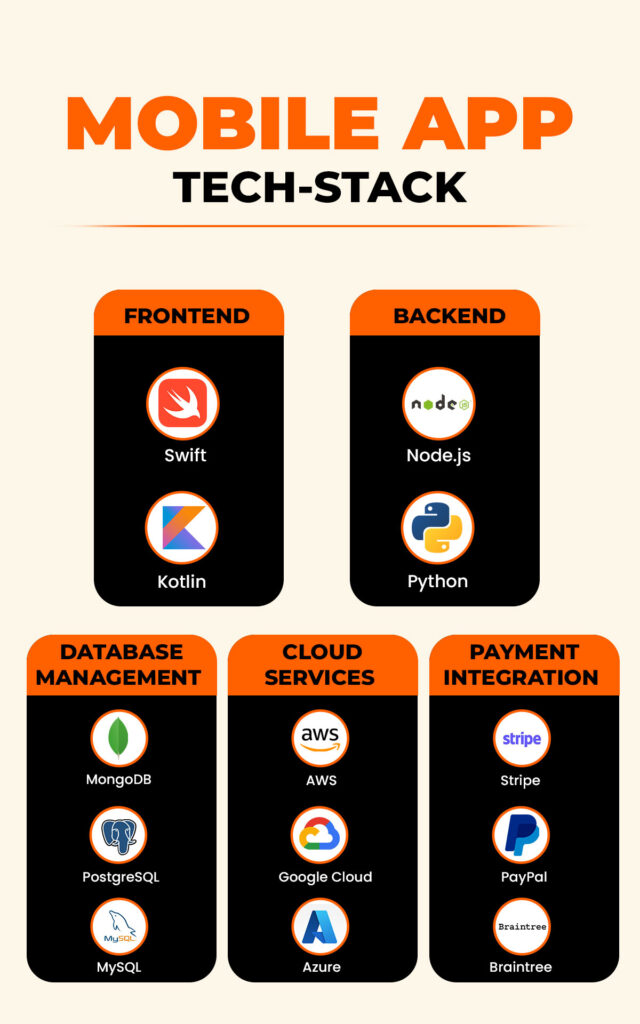
Frontend Development
For web apps, tools like React or Angular are best for making an interesting and flexible user experience. For mobile apps, Swift for iOS or Kotlin for Android are best. These technologies ensure users have a smooth and flexible experience on all platforms and devices.
Backend Development
Strong backend development is needed to handle operations, control users, process orders, and store data. Many people use languages like Node.js, Python (Django or Flask), and Ruby on Rails. They offer the flexibility and speed to handle large deals and data.
Database Management
You need a reliable database management system to store information about users, orders, restaurants, and other important things. You can use MongoDB, PostgreSQL, or MySQL based on the program’s speed, flexibility, and data accuracy needs.
Cloud Services
Hosting, storage, computing, and database services are just a few services cloud platforms like AWS, Google Cloud, and Azure offer. These systems make it possible to launch apps in a scalable, reliable, and safe way.
Payment Processing
It is very important to use safe and trusted payment platforms when processing deals. Users can choose different ways to pay using services like Stripe, PayPal, Braintree, and others.
Other Important Technologies
To improve the app’s release and operating efficiency, you could use extra tools and technologies like Docker for containerization, Jenkins for continuous development and delivery, and Kubernetes for coordination.
Testing & Deploy
Testing and deploying an app for food delivery is an important part of the app development process because it ensures the app is ready for the market, safe, and works well. Several steps make up this phase:
Quality Assurance (QA) Testing
The app goes through a lot of QA testing at first, which includes acceptance testing, unit testing, integration testing, and system testing. These tests ensure that each part works properly on its own and when put together with other parts to meet the needs of the whole system.
User Experience (UX) Testing
This type of testing looks at how easy it is to use, how accessible it is, and how the app’s design works. It involves real people using the app to find any problems with navigation or user experience. This ensures the app is easy to understand and use.
Performance Testing
This checks how well the app works in different situations, such as speed testing, load testing, and stress testing. It ensures that the app stays stable and quick even when there are a lot of users, network problems, or internal stress.
Testing for security
Security is very important to keep user info and activities safe. Security testing finds holes in the app and fixes them so that data is encrypted, payment methods are safe, and the app follows all laws and rules.
When the app is finished being tested and improved, it is sent to the live setting. Setting up servers and databases and ensuring the app’s stable and scalable technology are all parts of this. Cloud services can be used to make launching faster and easier and to handle traffic spikes.
Market Launch
Putting out a food service app on the market takes careful planning and marketing to ensure it does well:
- Pre-Launch Campaigns: Using social media, partnerships with influential people, and news statements to make a lot of noise about the app can build interest and excitement.
- App Store Optimization (ASO): Adding keywords, engaging captions, and appealing images to an app’s page in an app store can make it more visible and encourage people to download it.
- Begin Offers: Giving discounts, gifts, or other deals at the start can get people to try the app.
- Feedback Loop: Once the app is out there, setting up a feedback loop with users is important to find out what they think. This can help with making changes and improvements in the future.
- Continuous Marketing: Marketing needs to keep going even after the start to keep the site visible, bring in new users, and keep old ones. SEO, content marketing, email marketing, and focused ads can all be part of this.
Conclusion
People want things to be digital and easy, so making a food service app could be very profitable. The journey needs to be carefully planned and carried out to make smart investments in food delivery app development and learn about the fast-growing food business and how its markets work. To make an app that stands out for its usefulness, speed, and safety, you need to test it thoroughly, include the necessary features, and use a strong tech stack.
How well the app does in the market can also depend on how well the rollout and market launch plan is thought out. The app’s ways of making money and keeping people involved make it even more likely to grow and make money. People who want to start a business or make a food delivery app must be smart and creative during these stages to meet customer needs, make the most of market opportunities, and ensure long-term success.




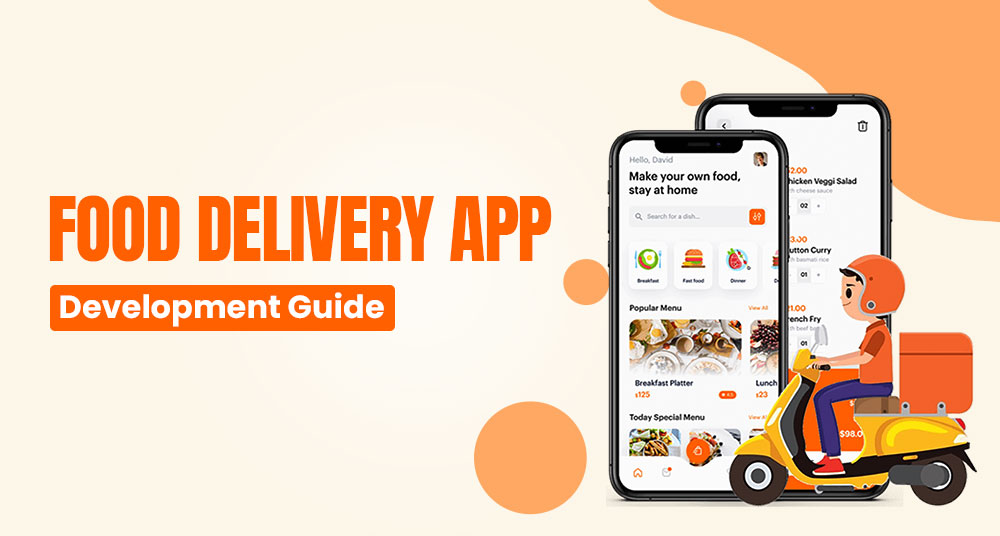

What do you think?
It is nice to know your opinion. Leave a comment.